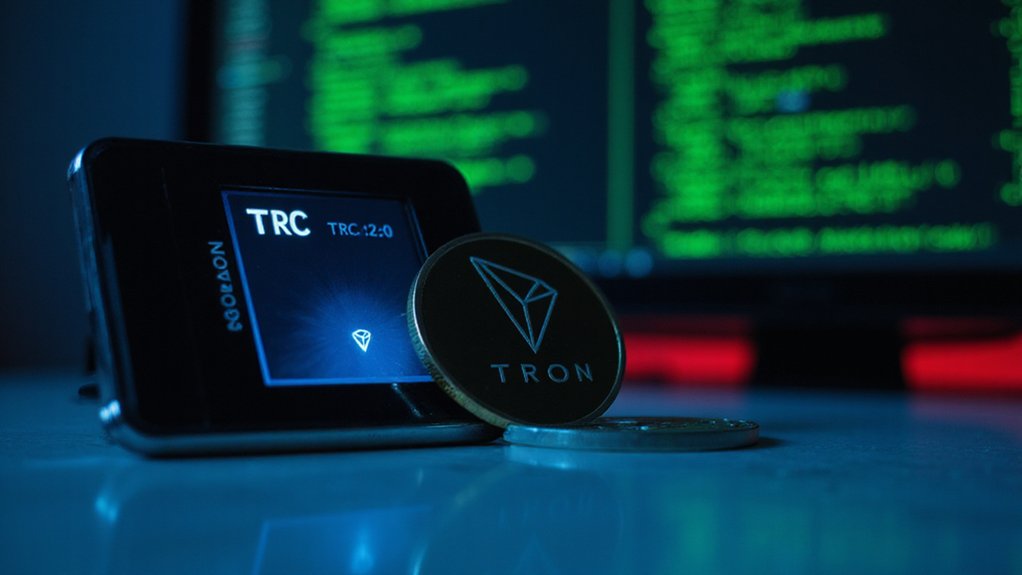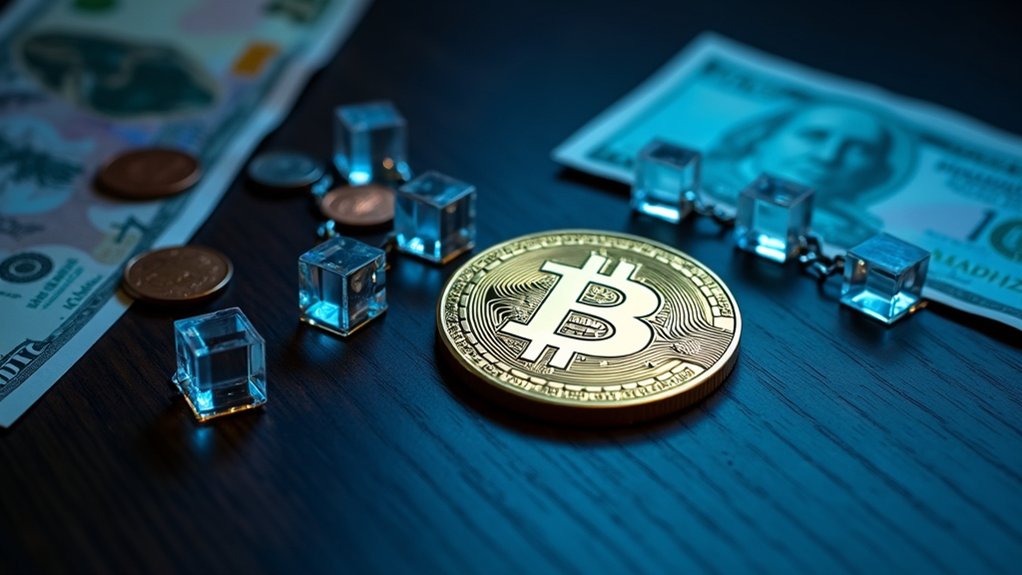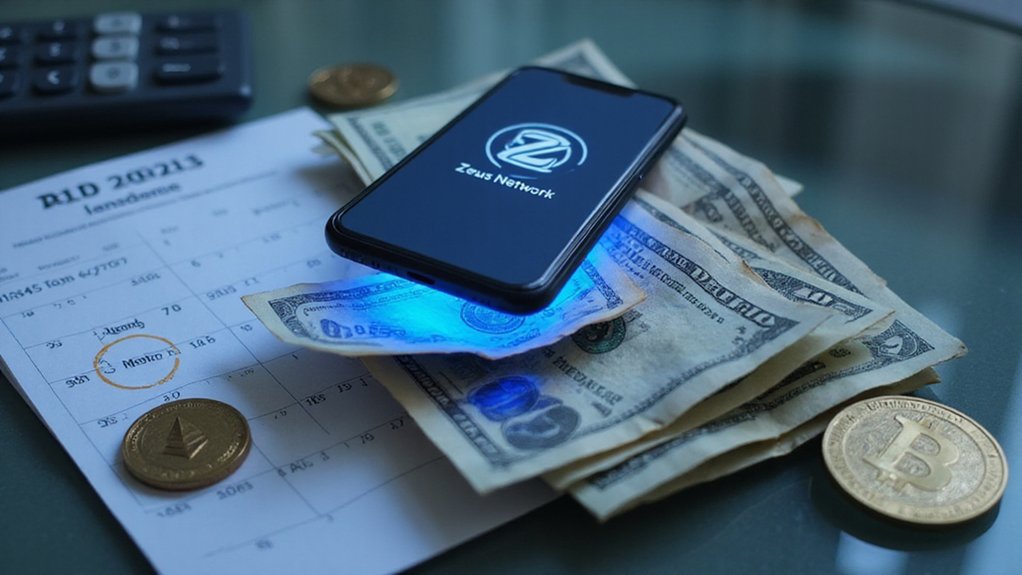TRC-20 is the standardized protocol governing token creation on the TRON blockchain—essentially Ethereum’s ERC-20 with better gas mileage. These smart contract-powered tokens implement mandatory functions like transfer and balanceOf, ensuring ecosystem-wide compatibility from wallets to exchanges. Supporting everything from stablecoins to DeFi applications, TRC-20‘s appeal lies in TRON’s superior transaction speeds and markedly lower fees (a welcome departure from Ethereum’s eye-watering costs). The technical specifications strike that elusive balance between robust functionality and practical implementation.

The TRC-20 token standard represents the technical backbone of fungible token creation on the TRON blockchain—a framework that has quietly revolutionized digital asset management while Ethereum’s gas fees continue their seemingly relentless climb.
Fundamentally a TRON-native counterpart to Ethereum’s ERC-20, this technical specification establishes a uniform protocol for developing interoperable tokens within the TRON ecosystem, enabling seamless integration across decentralized applications, exchanges, and wallet services.
TRC-20 establishes the digital syntax that allows tokens to communicate fluently across TRON’s expanding universe of decentralized services.
At its core, TRC-20 tokens are implemented via smart contracts on TRON’s blockchain infrastructure, with each contract encoding specific token behaviors and functionalities.
These smart contracts—self-executing agreements with predefined conditions—eliminate intermediaries while automating core functions like transfers, approvals, and balance inquiries.
The standard mandates implementation of specific functions (totalSupply, balanceOf, transfer, transferFrom, and approve) that collectively establish a predictable interface for all compliant tokens, regardless of their intended utility or market position.
The practical applications of TRC-20 tokens extend beyond mere cryptocurrency creation.
The standard underpins various digital assets including stablecoins (USDT on TRON being perhaps the most prominent example), utility tokens, and even tokenized securities. For optimal security of these valuable digital assets, many cryptocurrency investors utilize Ledger hardware wallets that store private keys offline, protecting TRC-20 tokens from online vulnerabilities.
Its implementation in DeFi protocols has facilitated lending, staking, and trading with remarkable efficiency—particularly when compared with Ethereum’s often prohibitive transaction costs.
Users benefit from TRC-20’s integration with TRON-compatible wallets, where tokens can be stored alongside native TRX coins.
Similar to how the ERC-20 standard fostered growth in Ethereum’s ecosystem with over 350,000 assets, the TRC-20 standard has been instrumental in blockchain innovation within the TRON network.
Transactions occur with significantly reduced fees and accelerated confirmation times, making micropayments economically viable (a feat that remains largely theoretical on certain competing networks).
The standard’s advantages—high throughput, scalability, and cost-efficiency—have attracted developers and users alike, particularly those priced out of Ethereum’s increasingly exclusive ecosystem.
The TRC-20 smart contract standard follows precise specifications consisting of six required items and three optional items that ensure tokens maintain compatibility across the ecosystem.
For enterprises and developers exploring the landscape of token standards, TRC-20 presents a compelling alternative—one that balances technical robustness with practical usability, all while leveraging TRON’s established network effects and growing developer community.
Frequently Asked Questions
How Does TRC-20 Compare to ERC-20 Tokens?
TRC-20 tokens offer a stark contrast to their ERC-20 counterparts, primarily excelling in transaction speed (3 minutes versus 15) and substantially lower fees.
However, this efficiency comes at the cost of security and decentralization—TRON’s network relies on merely 27 validators compared to Ethereum’s robust ecosystem of 500,000+ nodes.
The choice between protocols ultimately hinges on one’s priorities: TRON’s cost-effectiveness and speed versus Ethereum’s superior security and ecosystem support.
What Are the Transaction Fees for TRC-20 Tokens?
TRC-20 transaction fees operate on a dual-tier structure: approximately $1.70 (13.4 TRX) when sending to wallets already holding USDT, or a steeper $3.40 (27.25 TRX) for virgin wallets requiring initialization.
Unlike Ethereum’s congestion-based pricing rollercoaster, TRON maintains consistent fees regardless of network traffic—though they remain tethered to TRX’s market value.
Savvy users can eliminate these costs entirely by freezing TRX to generate the requisite energy and bandwidth resources.
Can I Store TRC-20 Tokens in Any Wallet?
TRC-20 tokens cannot be stored in just any cryptocurrency wallet.
Users must select wallets explicitly designed to support the TRON network’s token standard.
Mobile options (Trust Wallet, Guarda), desktop solutions (Atomic Wallet), hardware devices (Ledger Nano series), and web wallets all offer TRC-20 compatibility—with varying security features.
Wallets primarily designed for Ethereum or Bitcoin ecosystems typically lack TRC-20 support, a limitation that catches many crypto newcomers unawares when attempting cross-network transfers.
How Secure Are TRC-20 Tokens Against Potential Hacks?
TRC-20 tokens inherit robust security from TRON’s underlying blockchain architecture, but their ultimate safety hinges on smart contract implementation.
While the protocol itself remains uncompromised historically, vulnerabilities typically emerge from flawed contract code rather than protocol weaknesses.
Security-conscious investors should scrutinize contract audits and developer expertise before commitment—a well-designed TRC-20 token offers considerable protection, though no blockchain asset exists entirely immune to exploitation (the eternal cat-and-mouse game of crypto security continues unabated).
What Major Projects Currently Use the TRC-20 Standard?
*Remarkable how rapidly adoption has accelerated, given TRON’s relatively recent emergence.









